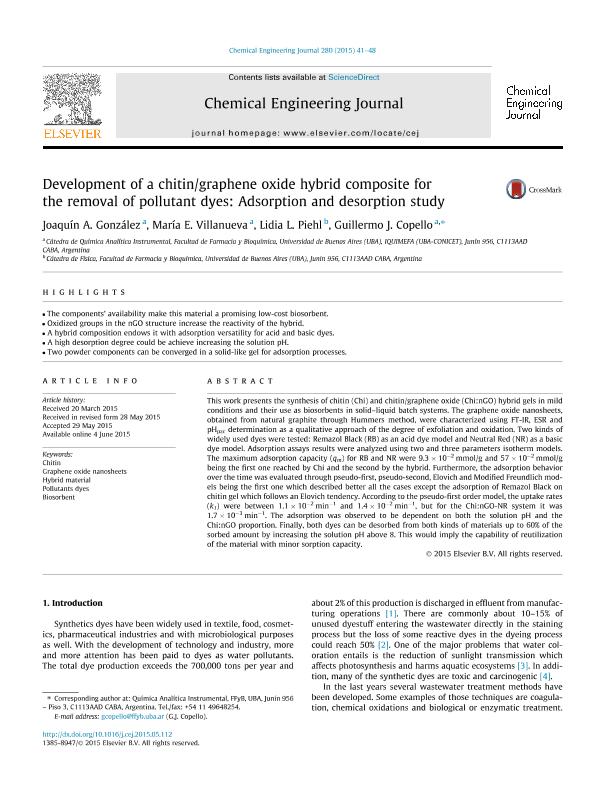Mostrar el registro sencillo del ítem
dc.contributor.author
González, Joaquín Antonio

dc.contributor.author
Villanueva, María Emilia

dc.contributor.author
Piehl, Lidia Leonor

dc.contributor.author
Copello, Guillermo Javier

dc.date.available
2018-03-15T17:07:10Z
dc.date.issued
2015-11
dc.identifier.citation
González, Joaquín Antonio; Villanueva, María Emilia; Piehl, Lidia Leonor; Copello, Guillermo Javier; Development of a chitin/graphene oxide hybrid composite for the removal of pollutant dyes: Adsorption and desorption study; Elsevier Science Sa; Chemical Engineering Journal; 280; 11-2015; 41-48
dc.identifier.issn
1385-8947
dc.identifier.uri
http://hdl.handle.net/11336/38916
dc.description.abstract
This work presents the synthesis of chitin (Chi) and chitin/graphene oxide (Chi:nGO) hybrid gels in mild conditions and their use as biosorbents in solid-liquid batch systems. The graphene oxide nanosheets, obtained from natural graphite through Hummers method, were characterized using FT-IR, ESR and pHpzc determination as a qualitative approach of the degree of exfoliation and oxidation. Two kinds of widely used dyes were tested: Remazol Black (RB) as an acid dye model and Neutral Red (NR) as a basic dye model. Adsorption assays results were analyzed using two and three parameters isotherm models. The maximum adsorption capacity (qm) for RB and NR were 9.3×10-2mmol/g and 57×10-2mmol/g being the first one reached by Chi and the second by the hybrid. Furthermore, the adsorption behavior over the time was evaluated through pseudo-first, pseudo-second, Elovich and Modified Freundlich models being the first one which described better all the cases except the adsorption of Remazol Black on chitin gel which follows an Elovich tendency. According to the pseudo-first order model, the uptake rates (k1) were between 1.1×10-2min-1 and 1.4×10-2min-1, but for the Chi:nGO-NR system it was 1.7×10-3min-1. The adsorption was observed to be dependent on both the solution pH and the Chi:nGO proportion. Finally, both dyes can be desorbed from both kinds of materials up to 60% of the sorbed amount by increasing the solution pH above 8. This would imply the capability of reutilization of the material with minor sorption capacity.
dc.format
application/pdf
dc.language.iso
eng
dc.publisher
Elsevier Science Sa

dc.rights
info:eu-repo/semantics/openAccess
dc.rights.uri
https://creativecommons.org/licenses/by-nc-nd/2.5/ar/
dc.subject
Biosorbent
dc.subject
Chitin
dc.subject
Graphene Oxide Nanosheets
dc.subject
Hybrid Material
dc.subject
Pollutants Dyes
dc.subject.classification
Otras Ciencias Químicas

dc.subject.classification
Ciencias Químicas

dc.subject.classification
CIENCIAS NATURALES Y EXACTAS

dc.title
Development of a chitin/graphene oxide hybrid composite for the removal of pollutant dyes: Adsorption and desorption study
dc.type
info:eu-repo/semantics/article
dc.type
info:ar-repo/semantics/artículo
dc.type
info:eu-repo/semantics/publishedVersion
dc.date.updated
2018-03-13T18:12:46Z
dc.journal.volume
280
dc.journal.pagination
41-48
dc.journal.pais
Países Bajos

dc.journal.ciudad
Amsterdam
dc.description.fil
Fil: González, Joaquín Antonio. Consejo Nacional de Investigaciones Científicas y Técnicas. Oficina de Coordinación Administrativa Houssay. Instituto de Química y Metabolismo del Fármaco. Universidad de Buenos Aires. Facultad de Farmacia y Bioquímica. Instituto de Química y Metabolismo del Fármaco; Argentina
dc.description.fil
Fil: Villanueva, María Emilia. Consejo Nacional de Investigaciones Científicas y Técnicas. Oficina de Coordinación Administrativa Houssay. Instituto de Química y Metabolismo del Fármaco. Universidad de Buenos Aires. Facultad de Farmacia y Bioquímica. Instituto de Química y Metabolismo del Fármaco; Argentina
dc.description.fil
Fil: Piehl, Lidia Leonor. Universidad de Buenos Aires. Facultad de Farmacia y Bioquímica; Argentina. Consejo Nacional de Investigaciones Científicas y Técnicas; Argentina
dc.description.fil
Fil: Copello, Guillermo Javier. Consejo Nacional de Investigaciones Científicas y Técnicas. Oficina de Coordinación Administrativa Houssay. Instituto de Química y Metabolismo del Fármaco. Universidad de Buenos Aires. Facultad de Farmacia y Bioquímica. Instituto de Química y Metabolismo del Fármaco; Argentina
dc.journal.title
Chemical Engineering Journal

dc.relation.alternativeid
info:eu-repo/semantics/altIdentifier/url/http://www.sciencedirect.com/science/article/pii/S1385894715008001
dc.relation.alternativeid
info:eu-repo/semantics/altIdentifier/doi/http://dx.doi.org/10.1016/j.cej.2015.05.112
Archivos asociados
